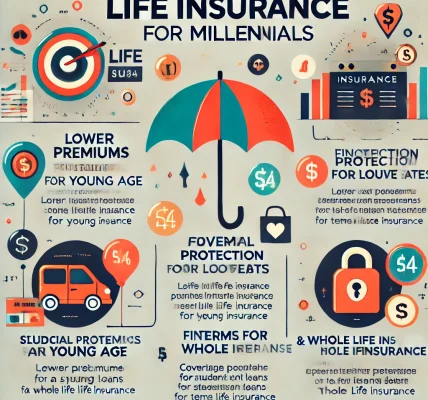Introduction
Life insurance is one of the most misunderstood financial products. Many people delay purchasing a policy or avoid it altogether due to common misconceptions. These myths can prevent individuals from securing their family’s financial future.
In this DIY guide, we will debunk the top myths about life insurance and provide you with the facts, so you can make an informed decision about protecting your loved ones.
Myth #1: Life Insurance is Only for Older People
Reality: Life insurance is beneficial at any age.
One of the biggest misconceptions is that life insurance is only for older individuals or people nearing retirement. In reality, the earlier you buy life insurance, the better. Purchasing a policy at a younger age means:
- Lower premiums due to better health.
- Longer-term financial protection for your loved ones.
- More time for cash value accumulation (if opting for whole life insurance).
DIY Tip: Consider buying life insurance as soon as you start earning, even if you have no dependents. You’ll lock in lower premiums for the future.
Myth #2: Life Insurance is Expensive
Reality: Life insurance is more affordable than you think.
Many people assume that life insurance is too costly and beyond their budget. However, term life insurance plans are quite affordable, especially if you buy early.
For example, a healthy 30-year-old can secure a $500,000 term policy for as little as $20 per month—less than what most people spend on coffee.
DIY Tip: Use an online insurance calculator to compare policies and find one that fits your budget.
Myth #3: Employer-Provided Life Insurance is Enough
Reality: Employer life insurance may not offer sufficient coverage.
While many companies offer life insurance as part of their benefits package, the coverage is usually limited (e.g., one or two times your salary). This may not be enough to support your family in case of your untimely passing.
Moreover, if you leave your job, you may lose your employer-provided life insurance.
DIY Tip: Always consider purchasing an individual life insurance policy in addition to any employer-sponsored plan to ensure full coverage.
Myth #4: Stay-at-Home Parents Don’t Need Life Insurance
Reality: Stay-at-home parents contribute significant financial value.
Many believe that only the working spouse needs life insurance, but this is far from the truth. Stay-at-home parents provide services that would be costly to replace, such as childcare, housekeeping, and meal preparation.
If a stay-at-home parent passes away, the surviving spouse may need financial assistance to cover these responsibilities.
DIY Tip: Both working and non-working spouses should have life insurance to ensure financial stability for the family.
Myth #5: I Don’t Have Dependents, So I Don’t Need Life Insurance
Reality: Life insurance serves more than just dependents.
Even if you are single with no dependents, life insurance can still be valuable. It can help cover funeral expenses, outstanding debts, or even leave a financial legacy for loved ones.
Additionally, purchasing a policy early means lower premiums and guaranteed coverage if your health changes in the future.
DIY Tip: Consider life insurance as part of your long-term financial plan, even if you don’t have dependents now.
Myth #6: Life Insurance Payouts are Taxable
Reality: Life insurance death benefits are usually tax-free.
Many believe that life insurance payouts are subject to income tax, but in most cases, beneficiaries receive the death benefit tax-free. However, if the policyholder has a large estate, estate taxes may apply.
DIY Tip: Speak with a financial advisor if your estate is large to understand potential tax implications.
Myth #7: Life Insurance is Only for Death Benefits
Reality: Some life insurance policies offer living benefits.
Permanent life insurance (such as whole life or universal life) has a cash value component that grows over time. Policyholders can borrow against this cash value, use it for retirement, or withdraw funds if needed.
DIY Tip: If you’re looking for both protection and investment growth, consider a permanent life insurance policy.
Myth #8: Pre-Existing Health Conditions Make Life Insurance Unaffordable
Reality: You can still get coverage, even with health issues.
While pre-existing conditions like diabetes or high blood pressure can affect your premiums, many insurance companies offer policies tailored for individuals with health conditions. Some insurers also provide guaranteed issue life insurance, which does not require a medical exam.
DIY Tip: Compare different insurance providers and consider policies designed for individuals with pre-existing conditions.
Myth #9: Life Insurance is Not Necessary If You Have Savings
Reality: Savings may not be enough to replace lost income.
While savings and investments are important, they may not be enough to support your family long-term if you pass away unexpectedly. Life insurance ensures that your loved ones have immediate financial support without depleting savings.
DIY Tip: Consider life insurance as a financial safety net that complements your savings and investments.
Myth #10: Once You Buy Life Insurance, You Can Forget About It
Reality: Life insurance needs change over time.
Your life circumstances—marriage, children, new debts, or career growth—affect how much coverage you need. It’s essential to review your policy regularly to ensure it still meets your financial goals.
DIY Tip: Reassess your policy every few years or after major life events to update coverage as needed.
Conclusion
Life insurance is an essential financial tool, but misinformation often discourages people from getting the coverage they need. By debunking these myths, you can make a well-informed decision and secure your family’s financial future.



